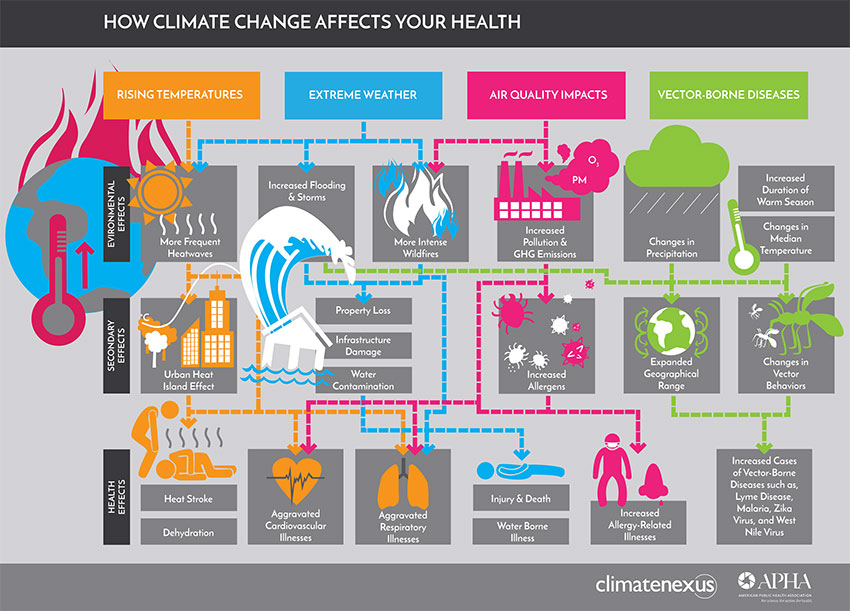CLIMATE & HEALTH
DHS Website - Climate & Health
DHS Website - Infectious Diseases and Climate Change in Wisconsin

Climate change threatens the fundamentals that sustain life and health—fresh water, food, clean air, shelter, and security—and thus threatens the health of the communities that local health departments serve.
Learn more about the health impacts of climate change.
AIR QUALITY
Informational Links:
CDC - Cold weather and carbon monoxide safety (safe heating)
DNR - Investigations related to citizen complaints of poor outdoor air quality
EPA - Indoor air quality issues
WATER QUALITY
Blue-Green Algae: WI DNR Website
Drinking Water Informational Links:
CDC - Lead in drinking water
DNR - Well water information
To learn more about the drinking water in your community, you can visit the following websites for more information:
Glendale/Whitefish Bay/Fox Point
Bayside
Shorewood
Brown Deer
HAZARDOUS/TOXIC MATERIALS
Informational Links:
Pesticides
When spraying pesticides, follow the directions on the label that tells you not to spray when the wind speed is above a certain threshold. In the absence of specific label directions, the wind speed should be AT LEAST 3 and NO MORE THAN 8 miles per hour blowing in a direction away from sensitive areas. Wind speeds above 8 mph substantially increase the risk of spray drift to downwind areas adjacent to the application site. Wind speeds below 3 mph are often variable and may change direction rapidly (Source).
More information on pesticides is available in this WI DNR publication: Wisconsin Forest Management Guidelines
Lead
Lead is a naturally occurring element found in small amounts in the earth’s crust. No safe blood lead level has been identified. For infants and young children, lead levels of 5 micrograms or more in a deciliter of blood are levels of concern and can damage ability to learn. Young children face the most danger from exposure to lead because their growing bodies are more prone to harm and also children absorb lead more easily than do adults' bodies.
Visit our Lead page for more information
Radon
- Visit our Radon Awareness page to learn more about Radon in the North Shore and Wisconsin.
- You can also learn more about the sell short-term radon testing kits NSHD sells for $8.00 a kit.
Mold
WI Department of Health Services Mold Toolkit
Mold is a type of fungi that is everywhere around us. However, mold can become a problem when it grows unchecked inside a home. If there is sufficient moisture, along with an organic food source, mold may proliferate in your home. To learn more about mold, including how it may affect your health and how to remove it from your home, visit the EPA's website: Mold
5 Key Points About Mold
1. Moisture control is key—find the source of moisture, repair, and clean the mold.
2. Testing is usually not necessary. If you can see or smell mold, it is present.
3. Most people do not react to mold, but people with allergies, respiratory conditions, or weakened immune systems can experience health effects.
4. Tenant and landlord resources are available to help navigate conflict, repair, and cleaning issues.
5. Additional information and resources can be found by visiting the DHS mold webpages or by calling a mold contractor, building inspector, or indoor air consultant.
NEEDLES/SHARPS
NSHD does not accept needles or sharps.
For information on managing household medical sharps, visit:
http://dnr.wi.gov/topic/healthwaste/householdsharps.html
MEDICATION DISPOSAL
NSHD does not accept expired or unused medications for disposal. However, we may have safe disposal products available. Contact us to find out more.
In addition to National Drug Take Back Days (April and October, yearly), many police departments, including those in the North Shore, will accept expired or unused medications for disposal.
WISCONSIN BEACHES
NSHD Wisconsin Beaches Webpage - Learn about beach water testing in the North Shore!
To view beach water conditions for Wisconsin beaches visit the WI DNR website
Prior to swimming at any of the beaches in the North Shore, it is important to consult https://www.weather.gov/greatlakes/beachhazards for information on the weather and temperature conditions to determine current risks for swimming.
FOOD SAFETY FOR CONSUMERS
North Shore Environmental Health Consortium Licensing
Guidelines for Eating Fish:
Federal and State agencies suggest limits for how much locally-caught fish people should eat. Limits for many fish are lower for children and women who are or may become pregnant, than they are for men. These advisories exist because of mercury and polychlorinated biphenyl (PCB) contaminants found in fish. Check out the Wisconsin DNR Fishing Wisconsin website for more information about potential contaminants in fish caught from Wisconsin waters.
Several reference guides concerning safe fish consumption are available, including the City of Milwaukee Health Department: 2013 Guidelines for Eating Fish from Milwaukee Waters with recommendations specific to Milwaukee area residents.
In addition, the Wisconsin DNR has issued their 2016 Choose wisely: A health guide for choosing fish in Wisconsin available for review or print. They have also produced the Fish Consumption Advice for the Milwaukee Estuary Area of Concern guide for fish information regarding the Milwaukee region.
The FDA and EPA issue advice about how much store-bought fish (generally ocean-caught) to eat. Mercury is the main contaminant of concern in ocean-caught fish. Click here for the most current information from the FDA.
Content updated 12/20/2024